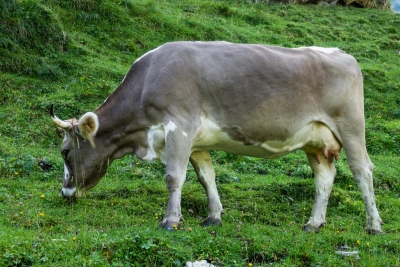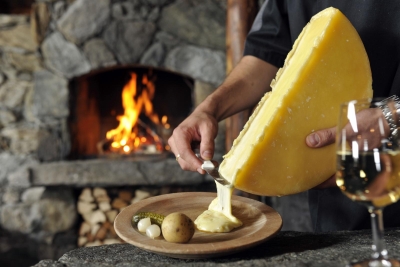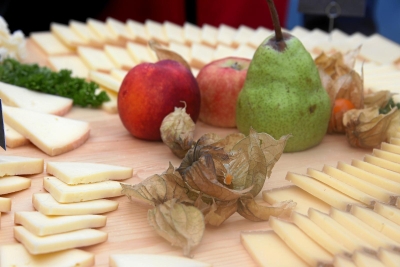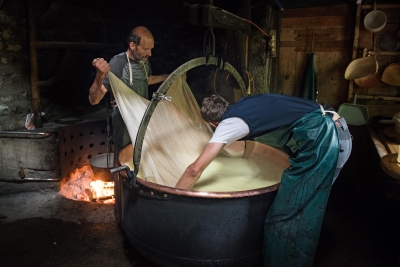- Trips
- Tour Calendar
- About Our Tours
- Plan a Trip
- Book a Trip
- About Us
- Contact Us


The Swiss take their cheese seriously; and not surprisingly, cheese is big business in Switzerland, where they produce about 180,000 tons of cheese a year and export about a third of all they produce. Most Swiss cheeses are mountain cheeses—made with raw alpine milk. They are firm, long-aged cheeses with pronounced flavor. Today, modern technology is used to produce most of the cheese, yet for the most part it's still made in hundreds of small dairies using milk produced locally on small farms.

What North Americans know generically as "Swiss Cheese"—the white rubbery stuff with holes—is generally not made in Switzerland. It's a sorry knock-off of the real deal—Emmentaler—made in the valley of the river Emme, or Emmental. Only after you travel in Switzerland and savor the piquant but not too sharp taste of Emmentaler can you claim to have tasted real Swiss cheese. Where do the holes come from? Well first of all, the holes are more appropriately known as "eyes." In the late stages of the cheese production, the propionibacteria consumes the lactic acid and releases carbon dioxide gas, which forms the bubbles or eyes. For the ultimate cheese tour in Switzerland, where you'll have the opportunity to witness first hand the cheesemaking process in both its traditional style and in modern commercial dairies, you'll want to reserve a place on Alpenwild's Cheese Chocolate, and the Scenic Alps tour. You'll discover the cheeses of Switzerland in all their wonderful varieties.
A visit to one of the classic Appenzeller dairies is always a favorite stop, and walking into any restaurant and breathing in the aroma of rösti or quiche made with Appenzeller cheese is always a delight. The distinctive aroma of Appenzeller cheese is a result of the curing process as an herbal brine including cider, white wine, peppercorns, and mountain herbs is applied to the cheese in a bath lasting up to two months. The cheese is produced by about 75 dairies in the Appenzell region and according to a 700-year-old recipe. The cheese has tiny holes and a golden rind. It's an assertive cheese with a recognizable and strong smell and a nutty or fruity flavor and begs for a glass of sauvignon blanc.

Raclette cheese, produced in the canton of Valais, is especially well-suited to melting. It's a semi-firm cow's milk cheese typically fashioned into 6 kg rounds. The AOC (Appellation d'origine contrôlée) was granted to Raclette cheese from Valais in 2003. In addition to the cheese itself, raclette is also the name of a popular dish served throughout Switzerland consisting of melted cheese (ideally Raclette cheese) served with potatoes, gherkins, and pickled onions.
Le Gruyère is a hard yellow cheese made from cow's milk, named after the town of Gruyères. It's currently produced in the cantons of Fribourg, Vaud, Neuchâtel, Jura, and Bern. With its distinctive but not overpowering taste, Gruyère is one of the finest cheeses for baking and melting. Gruyère obtained AOC status in 2001. It's widely used in traditional Swiss fondues, along with Vacherin and Emmental.

Alp Cheese is only produced in the summer months in Alpine dairies. The milk used comes from cows that spend the summer up on the Alps. Alp Cheese does not refer to a single uniform product, but to a whole range of regional Alpine cheeses. Each cheese has at least as much individual character as the Alpine cheesemaker that produces it and varies by region depending on the grasses and alpine herbs on which the cows graze. The varying hints in the taste of Alp cheese can come from the wood fire used to heat the milk as well as the particular style of the cheesemaker. You'll enjoy Alp cheese on all of our hiking tours in the Alps.

And finally, our vote for the finest, most decorated, and most sinfully rich cheese in all of Switzerland, goes to Vacherin Mont d'Or. It's both a classic dessert cheese and served with fresh bread or hot from the oven and spooned over potatoes with a little pepper. Vacherin typically contains 45-50 percent milk fat. It's produced between August 15 and March 15 and sold between September 10 and May 10—so you're not likely to find it on a summer hiking tour, and its not widely imported to the US. This rare delight is produced only by select dairies in the Jura mountains of western Switzerland.
First made in the 12th century by monks at the Bellelay monastery in the Bernese Jura, Tête de Moine is now made by dairies in that same region. The name means "monk's head." It has a buttery, savory flavor that is best revealed as the cheese in shaved into rosettes with a cutter called a "girolle" designed specifically for this cheese.
Sbrinz is Switzerland's and perhaps Europe's oldest cheese whose roots can be traced back to 70 AD. Often considered "Swiss Parmesan," Sbrinz is hard cheese made with raw milk in 30 selected valley dairies in central Switzerland. Ideally, the cheese should be aged at least 24 months before being eaten. In stores, Sbrinz is often sold in sliced curls.
Just reading about Swiss Cheese will never fully satisfy. Join us in Switzerland this summer for our Cheese, Chocolate & the Alps tour. You'll discover some of the world's finest cheeses at the source.